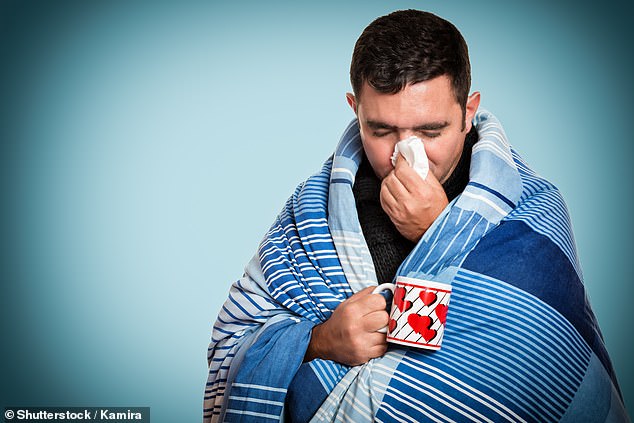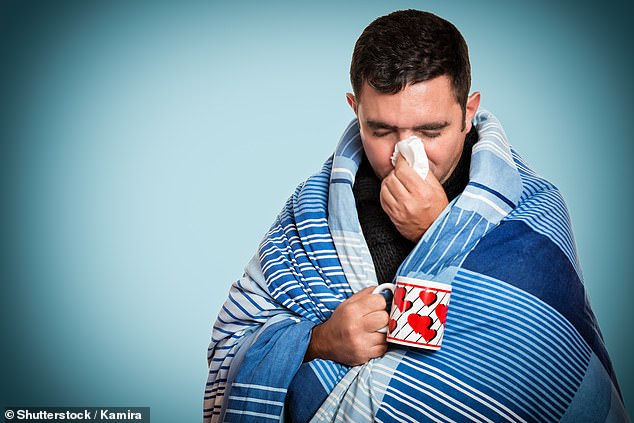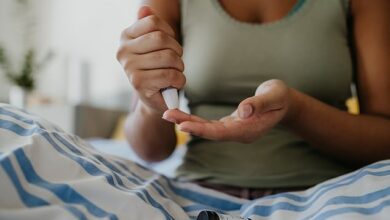How soon until you feel sick after catching someone else’s illness? From measles to colds, flu and Covid, our expert guide to when the symptoms will hit…




Sitting next to someone with a hacking cough on a crowded plane or train, hearing the friend you had a drink with last night has since tested positive for Covid, or your child’s schoolfriend has thrown up in the classroom, most of us fear the worst and wonder if, or simply just when, we’ll come down with the same lurgy.
With summer holidays coming up, Covid infections still circling, and news of measles outbreaks, many of us will be feeling nervous about getting ill with at least one of them.
When we do come down with a bug, we often try to work out ‘whose fault it was’ — a kind of blame game that’s often seen in homes and workplaces alike. But not all infections spread as easily as others.
This depends on the interplay of factors, including how robust the infected person’s immune system is and the incubation period, i.e. the number of days it takes for symptoms to appear after someone is infected with a virus.

You catch cold or flu by inhaling particles of the virus, usually in a droplet of mucus from someone who is infected, via coughs or sneezes – but also from touching surfaces that have been contaminated, says Professor Eccles
But one of the most important factors is the pathogen’s reproduction rate (or R rate), a measure of how contagious it is, based on the average number of secondary infections one person causes.
An R rate of 1 means that on average every person who is infected will infect one other person.
Interestingly, two of the most infectious diseases of all are measles (caused by a virus, morbillivirus) and whooping cough (caused by a bacterium, Bordetella pertussis), with the highest R rates — 15-20 and 15-17 respectively. This means one infected person can infect up to 20 others with measles, and up to 17 for whooping cough.
This is why recent measles outbreaks in Birmingham and London caused such concern, as nine in ten people who’ve been in a room with someone infected will catch it if they don’t have immunity either from past exposure or from vaccination.
At the other end of the spectrum, tuberculosis (TB), one of the deadliest infectious diseases, has an R rate in the UK of less than 1 (although higher in other parts of the world where it’s more prevalent), which means an infected person is unlikely to infect someone else — you’d need prolonged close contact to catch it, not just sitting next to someone on a bus, for instance.
Bugs that spread well have certain characteristics that help them do this. For example, the bacterium that leads to whooping cough causes a cough for six to ten weeks, to maximise its spreading potential.
Also unique to each bug is its incubation period — with some infections (e.g. common cold) you will notice symptoms within a few days after exposure, but with others it can take several weeks for any symptoms to appear. For instance, measles and chickenpox (caused by the varicella-zoster virus) have an incubation period of up to three weeks.

Most viruses infect us via the same mechanism. Whether they enter through nasal passages, orally or via the skin, they get into cells and hijack the machinery to aid replication. They then burst out and travel around to infect more cells
Whether or not an infected person is contagious during the incubation period depends on the type of infection — with measles and chickenpox, for example, the individual may be unaware they are infected and could be spreading the viral droplets to others for weeks before their own symptoms appear.
‘It’s not clear why some have a longer incubation period than others, but it’s probably because they are evading the immune system,’ says Ron Eccles, an emeritus professor and former director at the Common Cold Centre at Cardiff University.
‘A range of factors will affect whether you catch an infection or not, including how much of the virus the person you are in contact with is ‘shedding’ at that moment; whether you are in an enclosed space or not; the temperature and humidity of the environment (for instance, cold viruses survive better in humid conditions) — and if you have immunity, as well as your age, general health and genes.’
Most viruses infect us via the same mechanism. Whether they enter through nasal passages, orally or via the skin, they get into cells and hijack the machinery to aid replication. They then burst out and travel around to infect more cells, explains Professor Eccles.
‘It’s at this stage that your immune system starts to detect the virus. In the first stage, the white cells will release peroxide chemicals that can damage or ingest the pathogens, but after five to ten days you start to produce antibodies that are specific to the virus which clear the body of the infection.
‘It’s this response that starts to generate symptoms, such as feeling shivery and hot: these are signs the body is trying to fight off the infection,’ he says.
Genetic factors may also play a part in whether you catch an infection and develop symptoms, adds Professor Sheena Cruickshank, an immunologist at the University of Manchester.
‘In studies where people are exposed to common viruses such as the common cold under laboratory conditions, some people don’t catch the viruses, whereas others become seriously ill,’ she says. ‘This is down to how efficient your immune system is and our genetics.
‘Also, the more immune you are to the pathogen, the less likely you are to be a good host for that virus to replicate and then spread to other people — which is an argument for vaccination; you’re not just protecting yourself, but others, too.’
We asked leading experts for the low down on the ‘catchability’ of some of the most common infections and how best to protect yourself.
MEASLES
WHAT IS IT: Caused by a virus, morbillivirus, this is very infectious and causes flu-like symptoms initially, and then a red, blotchy rash on the skin.
SPREADABILITY: The R rate (how contagious it is, based on the average number of secondary infections one person causes) is 15 to 20.
The measles virus spreads easily via droplets in coughs and sneezes (this is different from chicken pox, which can also get into skin particles that form a fine dust that is spread through the atmosphere).
The measles virus is airborne and you can catch it even two hours after an infected person has left the room.
INCUBATION PERIOD (how long it takes for symptoms to appear once infected): Seven to 18 days. On average, symptoms such as a cough, fever and runny or red eyes begin after ten to 12 days — these symptoms can look very similar to a common cold.
Three to five days after that, a skin rash will appear. ‘The measles rash usually starts behind the ears and spreads along the hairline and down the body,’ explain Dr Samira Neshat, a consultant critical care paediatrician at the Royal London Hospital in London and the private HCA The Portland Hospital for Women and Children.
This delayed response is because it takes time for immune cells to bind to the virus and they become stuck in the skin — ‘this is when spots appear’, says Professor Eccles.
HOW LONG ARE YOU INFECTIOUS? You can shed the virus and infect others from four days prior to the rash starting, to four days after the rash appears.
Dr Neshat says measles can be a scary disease unless you are vaccinated, or have immunity, because 30 per cent of people can develop complications such as severe diarrhoea and middle ear infection — and more serious complications such as encephalitis (an infection of the brain), which can prove fatal. ‘It’s so important to get your child vaccinated as full vaccination with two shots is 97 per cent effective against it.’
COMMON COLD AND FLU
WHAT IS IT: There are hundreds of different cold viruses — around 200, half of them are rhinoviruses (‘rhino’ means of the nose, and they are spread by respiratory droplets). There are more than 60 flu viruses — the four main strains are A, B, C and D; seasonal flu is caused by A and B strains, which mutate each year.
SPREADABILITY: R rate for both is 1 to 2 but can vary.
Cold and flu viruses spread easily; you’ll probably have more colds in your lifetime than any other disease. ‘This is because colds generally cause a mild illness and people go to work and school and keep spreading the viruses,’ says Professor Eccles. ‘Flu viruses are slightly more contagious as there are new ones every year, so you won’t have immunity to them and, as a result, they have more chance of successfully taking hold.
‘You catch cold or flu by inhaling particles of the virus, usually in a droplet of mucus from someone who is infected, via coughs or sneezes — but also from touching surfaces that have been contaminated with these droplets (the viruses can survive for a few hours outside the body) and then touching your mouth, nose or eyes,’ adds Professor Eccles.
‘The viruses can attach to cells at the back of the nose, and that’s where you’ll often get the first signs of infection — a sore or tickly throat, for instance.
‘While flu virus is slightly more infectious than a cold virus, the problem with colds is they cause a relatively mild illness and don’t provoke a strong antibody response, so you may catch the same virus again after a few weeks.’
INCUBATION PERIOD: 12 hours to three days of becoming infected with either type of infection.
HOW LONG ARE YOU INFECTIOUS? Up to 14 days after symptoms start, or even 1-2 days before. You are most infectious in the first three days of symptoms starting, then gradually less so as your immune system response kicks in.
‘Technically you can be infected and have no symptoms and still spread it — but this is unusual,’ says Professor Eccles.
NOROVIRUS
WHAT IS IT: Also known as the winter vomiting bug, this is a highly contagious virus, causing vomiting and diarrhoea. It can spread rapidly through households, hospital wards, care home and schools.
SPREADABILITY: R rate is 1.1 to 7.2.
It only takes less than 100 particles to make you sick, and people shed billions in their stools and vomit. It is airborne, so you can become infected by breathing it in, but also from infected food and water and contaminated surfaces (it can live on hard surfaces for 12 hours; soft surfaces such as carpets for up to 12 days).
INCUBATION PERIOD: 12 to 48 hours.
HOW LONG ARE YOU INFECTIOUS? The NHS says you are still infectious for 48 hours after your symptoms have stopped; but some studies suggest you can still spread it after several weeks.
The reason norovirus is so infectious is that it has so many methods of transmission and lingers for some time outside the body, says Professor Cruickshank.
‘It can spread easily as sometimes people don’t realise it’s airborne, and that if you don’t put the loo cover down, for instance, virus particles will be in the air and can be breathed in or contaminate nearby surfaces.
‘It also mutates every year and some strains are very good at evading the immune system, have higher replication rates and are better at getting into cells.’
COVID-19
WHAT IS IT: An infectious disease caused by the SARS-Cov-2 virus. It can latch on to cells all around the body, causing a wide range of symptoms, from a continuous cough and shortness of breath, to gut problems such as diarrhoea and vomiting.

Despite Covid-19 spreading easily, Professor Kucharski says: ‘There is a lot more immunity in the population now, because of vaccination and from catching the virus previously, so it will generally cause a milder illness than in 2020.’
SPREADABILITY: R rate is 1.9 to 3.9.
Like many viruses, Covid spreads easily via tiny droplets in coughs and sneezes — and to a lesser extent, touching an infected surface (the virus loses its infectiousness in six to 12 hours on surfaces, says Professor Eccles).
While it’s a respiratory infection primarily, this virus has the ability to attach to receptors throughout the body.
Adam Kucharski, a professor of infectious disease epidemiology at the London School of Hygiene & Tropical Medicine, says the reason Covid spread so effectively was that people were infectious before they developed symptoms — and that’s still the case.
‘From a virus transmission point of view, that works in the virus’s favour as you have a whole bunch of people shedding a lot of the virus unaware that they are infectious.
‘People might worry when they hear someone with a lingering cough in a public space, but by that stage it might be the tail end of their infection and the amount of virus coming out — if any — is lower.’
He adds that if one person is infected, the real-world risk of someone else in their household becoming infected is around 25 per cent.
INCUBATION PERIOD: 2 to 14 days. ‘People seem to be developing symptoms much more quickly now, within two days in some cases,’ says Professor Eccles.
HOW LONG ARE YOU INFECTIOUS? This varies depending on the quality and quantity of immunity you have (e.g. from vaccination or prior infection) — some people are no longer infectious after five days, but others can be infectious up to ten days, according to the NHS.
Danny Altmann, a professor of infectious diseases at Imperial College London, says that since the pandemic started four years ago, the Covid virus has changed. New variants have got better at spreading between cells in the body and better at evading our antibodies.
The latest Covid variant JN.1 is ‘magnificently better’ than the variant of a year ago, in terms of its ability to get into cells and the speed of spreading between them, he adds.
Despite it spreading easily, however, Professor Kucharski says: ‘There is a lot more immunity in the population to Covid now, because of vaccination and from catching the virus previously, so it will generally cause a milder illness than in 2020.’
WHOOPING COUGH
WHAT IS IT: Caused by a bacterium, Bordetella pertussis, it affects the lungs and airways, causing a cough that can last up to ten weeks.
SPREADABILITY: R rate is 15 to 17.
The bacteria sit in the cilia hairs inside the nose and spread easily through the air via sneezing and coughing.
INCUBATION PERIOD: 5 to 10 days.
HOW LONG ARE YOU INFECTIOUS? Cold-like symptoms start after the incubation period. Two weeks later, these can worsen into coughing fits (followed by a whooping sound as you gasp for air).
You are infectious from six days after becoming infected, when the flu/cold-like symptoms begin until three weeks after the coughing fits start. You can have symptoms for up to ten weeks, but not necessarily still be infectious. Treatment includes antibiotics and earlier treatment can reduce the severity of the coughing fits.
Dr Neshat says: ‘It’s not always obvious if someone has whooping cough in the early stages. It can appear to be nothing more than the common cold. The main difference is that, in babies, it can cause apnoea, which are life-threatening pauses in breathing. Babies in the UK are vaccinated at eight weeks against whooping cough routinely and this is the best way to get protection.’
A version of this article was originally published by the Mail on January 29




